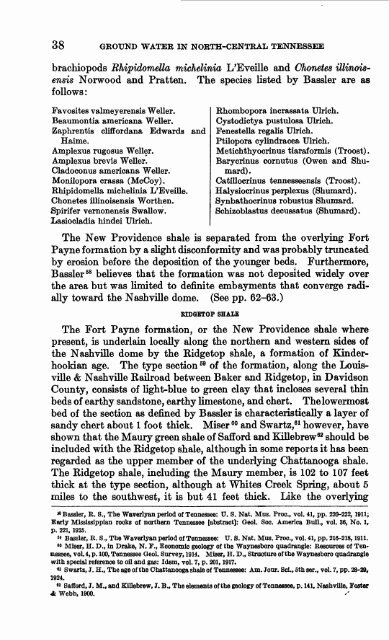GROUND WATER IN NORTH-CENTRAL TENNESSEE
GROUND WATER IN NORTH-CENTRAL TENNESSEE
GROUND WATER IN NORTH-CENTRAL TENNESSEE
Create successful ePaper yourself
Turn your PDF publications into a flip-book with our unique Google optimized e-Paper software.
38 <strong>GROUND</strong> <strong>WATER</strong> <strong>IN</strong> <strong>NORTH</strong>-<strong>CENTRAL</strong> <strong>TENNESSEE</strong><br />
brachiopods Rhipidomdla michelinia L'Eveille and Chonetes illinois-<br />
ensis Norwood and Pratten. The species listed by Bassler are as<br />
follows:<br />
Favosites valmeyerensis Weller.<br />
Beaumontia amerioana Weller.<br />
Zaphrentis oliffordana Edwards and<br />
Haime.<br />
Amplexus rugosus Weller.<br />
Amplexus brevis Weller.<br />
Cladoconus americana Weller.<br />
Monilopora crassa (McCoy).<br />
Rhipidomella michelinia L'Eveille.<br />
Chonetes illinoisensis Worthen.<br />
Spirifer vernonensis Swallow.<br />
Lasiocladia hindei Ulrioh.<br />
Rhombopora incrassata Ulrioh.<br />
Cystodictya pustulosa Ulrioh.<br />
Fenestella regalis UMoh.<br />
Ptilopora cylindraoea Ulrich.<br />
Metichthyocrinus tiaraformis (Troost).<br />
Barycrinus cornutus (Owen and Shumard).<br />
Catillocrinus tennesseensis (Troost).<br />
Halysiocrinus perplexus (Shumard).<br />
Synbathocrinus robustus Shumard.<br />
Schizoblastus decussatus (Shumard).<br />
The New Providence shale is separated from the overlying Fort<br />
Payne formation by a slight disconformity and was probably truncated<br />
by erosion before the deposition of the younger beds. Furthermore,<br />
Bassler 58 believes that the formation was not deposited widely over<br />
the area but was limited to definite embayments that converge radi<br />
ally toward the Nashville dome. (See pp. 62-63.)<br />
RIDGETOP SHALE<br />
The Fort Payne formation, or the New Providence shale where<br />
present, is underlain locally along the northern and western sides of<br />
the Nashville dome by the Ridgetop shale, a formation of Kinder-<br />
hookian age. The type section 69 of the formation, along the Louis<br />
ville & Nashville Railroad between Baker and Ridgetop, in Davidson<br />
County, consists of light-blue to green clay that incloses several thin<br />
beds of earthy sandstone, earthy limestone, and chert. The lowermost<br />
bed of the section as defined by Bassler is characteristically a layer of<br />
sandy chert about 1 foot thick. Miser 60 and Swartz,61 however, have<br />
shown that the Maury green shale of Safford and Killebrew62 should be<br />
included with the Ridgetop shale, although in some reports it has been<br />
regarded as the upper member of the underlying Chattanooga shale.<br />
The Ridgetop shale, including the Maury member, is 102 to 107 feet<br />
thick at the type section, although at Whites Creek Spring, about 5<br />
miles to the southwest, it is but 41 feet thick. Like the overlying<br />
88 Bassler, K. S., The Waverlyan period of Tennessee: U. S. Nat. Mus. Proc., vol. 41, pp. 220-222, 1911;<br />
Early Mississippian rocks of northern Tennessee [abstract]: Geol. Soc. America Bull., vol. 36, No. 1,<br />
p. 221, 1925.<br />
89 Bassler, R. S., The Waverlyan period of Tennessee: U. S. Nat. Mus. Proc., vol. 41, pp. 216-218,1911.<br />
6° Miser, H. D., in Drake, N. F., Economic geology of the Waynesboro quadrangle: Resources of Ten<br />
nessee, vol. 4, p. 100, Tennessee Geol. Survey, 1914. Miser, H. D., Structure of the Waynesboro quadrangle<br />
with special reference to oil and gas: Idem, vol. 7, p. 201,1917.<br />
M Swartz, J. H., The age of the Chattanooga shale of Tennessee: Am. Jour. Sci., 5th ser., vol. 7, pp. 28-29,<br />
1924.<br />
92 Safford, J. M., and Killebrew, J. B., The elements of the geology of Tennessee, p. 141, Nashville, Foster<br />
£ Webb, 1900.

















